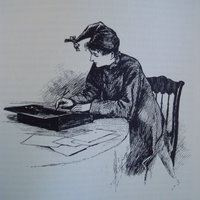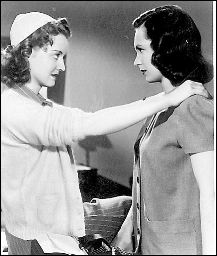Somewhere out there, in I think, the New Yorker forums, someone accuses Konigsberg of writing the most sensationalistic story in the NYer since the editorship of Tina Brown. I disagree with this, everything's a sensation - hair loss, weight loss, New Orleans, Osama's youth, all the rest of it. Why does this story seem more so, or offensively so?
This story has a dead child at the center of it. A big blinking sign that reads *sensationalism* . . . I've mentioned King Vidor's film The Crowd and one of my favorite things about this mythic American story is that the baby dies and the movie has to confront that. Exploring the social, cultural and material causes of the death of a child rather than just mourning it is, I think, a kind of taboo. Because no one wants to admit that right here in the good old US we exploit children (you know, like when we pimp them to/as pop stars and stuff).
Konigsberg's story is constructed as a mystery . . . He says on page one, "His suicide was a mystery to them." (45) Plus, Konigsberg seems like he's embedded (or discovered?) a mystery in his own family history as well, in his book Blood Relations, so this is his thing. The essay is called "Letter from Nebraska" and I know that's just a title, but it's a literary form too, one that suggests that the whole story is a subjective account of a historically real event. So no, it's not true and I don't have to believe it's true to follow along. It's Konigsberg's interpretation and I'd go so far as to say he's made himself the detective on the case. Who killed Brandenn Bremmer?
Clearly this is an engaging, popular style for people who didn't know the Bremmer's and aren't personally concerned with whether or not they are accurately represented. But speculations predate the NYer essay and given the wide range of evidence Konigsberg is sorting through, his readers can choose from a range of theories - Brandenn's isolation, his pushy parents, supernatural causes, the pain of living in this world, teen angst, those wacky Silvermans . . . but all theories are not equal to the detective himself.
Konigsberg reveals clues that would lead his readers to suspect the parents of pressuring Brandenn, or a kind of culture of "gifted-ness" and early acheivement that overwhelmed him and them too. At least it seems like the New Yorker readers, especially momo, picked up on this hypothesis. All the moments that readers cite as evidence for this - the high school transcript, the publicity efforts, the evidence of the music teacher, the unreliability of IQ testings are evidence that Konigsberg offers in his highly constructed account of the boy's life. Except that thing about his mother checking his heart everyday, which might be seen as corroborating evidence gathered by the local paper, but skews the story towards a kind of emotional angle that Konigsberg dwells on less. A similar theory out there somewhere is more attuned to the local media's role . . .
In any case, the NYer essay has a kind of repetitive structure in which Konigsberg offers what appears to be objective description of Brandenn's intelligence, "When he wasn't being challenged or engaged, he squalled" (47) followed by more qualified statements like "At the age of two, *the Bremmers say,* Brandenn read aloud all the Dr. Seuss books they could order from a book club." (47) Same with the IQ - he tells the story of the testing first as an uncomplicated proof of Brandenn's abilities (47), then he retells it critically, implicating the investment of Silverman and the Bremmer parents in producing this genius, "But some critics of the test say that it not only assesses higher scores; it tends to produce them." (48) It's this structure that I think makes emdashes statement, "as I remember it, Konigsberg expresses open skepticism only once, in a brief aside" sound a little, well, disingenuous. The essay is formally structured on skepticism. And that skepticism leads to an implied hypothesis. And that hypothesis is not so much the answer to who (really) killed Brandenn Bremer as it is to why might this death be interesting to New Yorker readers . . . .
So, in the end, I think Konigsberg was using the Bremmer's story to critically examine the culture gifted hype in the US and to engage readers who are also, probably (clearly if you read the comments), participants in variations on this culture in one way or another. I think he really wants to engage them in a kind of self-conscious reflection on, for one, this indigo child craze. Particularly the conflation of parent, child, emotion, affect and intelligence that the indigo child craze relies on.
***
But I'm a sucker for a good mystery and I say it was . . . .
THE BIBLIOGRAPHY!!!
Again, mostly what I've got to go on is the evidence Konigsberg assembled. So I'm not claiming this is the truth. I'm just saying that of all the issues the New Yorker essay raised, this is the one I'm interested in. Bibilography.
"There were a lot of new academic challenges. "He was kind of feeling his way along," [community college bio instructor] Morris said. "I'd assigned a term paper on natural history. I knew from talking to him that he'd never done anything like that, and of course he had to learn how to do the citations. And he was nervous. We talked about doing some typing of his notes and how that might help him. It was an adjustment for him, but he was going to be fine." (53)
Brandenn had not yet been taught to do research, keep notes or write a bibilography at the age of 14 and he was suddenly expected to do so. He could maybe learn to do it, though it would take the instructor, or his parents (who might not have known how to create such a paper) working through a number of steps with him and "backing up" a little bit to work from what he did know and understand . . . if I were spinning theories I'd say that this episode reveals how inadequetely educated Brandenn was for what he thought he wanted to acheive in the world beyond his family life - med school - and how frightening and discouraging this was when he began to realize it. Rather than accumulating lots of evidence for this theory, we'll have to let it stand as a microcosm of what happened when Brandenn began to be educated outside the farm.
For me the story is about how children and their assorted gifts are not and should not be considered the sole responsibility and/or property of their parents. They should be educated by the state to create bibliographies.
Related to this is another piece of evidence that Konigsberg doesn't do much with . . .
"When Brandenn was thirteen and taking time off from music class, Patti recalled, Martin had taught him construction. They'd gutted the barn, put in insulation and sheeting, and reinforced the walls with two-by-sixes. Over a single weekend, Brandenn learned woodworking and how to pour concrete, and he put up most of the aluminum siding himself." (57)
On the one hand, Konigsberg's language plays into the *amazing Brandenn !!* story, with the "over a single weekend" and "he put up most of the aluminum siding himself" claims. On the other hand, this is one of the most concrete and analytical descriptions of learning and teaching given in the whole article. Which isn't saying much - Brandenn's education is shrouded in mystery (the music teacher's story, and the bio teacher's story, above are about as detailed as this, everything else, reading, math, science, history even less). Anyway, we can use it for my argument. There are lots of different types of education and a smart kid and a good teacher can acheive a substantial amount if given time and freedom, but this ain't pre-med and the transition between light construction and intro bio isn't easy, inevitable, natural or the responsibility of your biological father.









